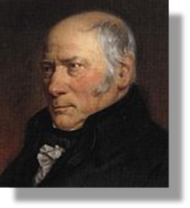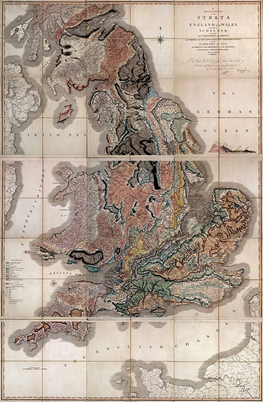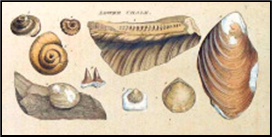


xxxxxIt was while working as a surveyor in the building of canals that the English geologist William Smith realised that layers of rock could be identified by the fossils contained within them. After carrying out research across the whole of the country, in 1815 he published his geological map of England, Wales and part of Scotland. The first of its kind, this was a milestone in the study of the earth’s crust, and the dating of the past. He later produced geological maps of 21 counties. For this work, spanning over twenty-
WILLIAM SMITH 1769 -
 xxxxxIt was while working as a canal surveyor, in charge of excavations, that the English geologist William Smith came to realise that layers of rock could be identified by the fossils contained within them. Over a period of some twenty-
xxxxxIt was while working as a canal surveyor, in charge of excavations, that the English geologist William Smith came to realise that layers of rock could be identified by the fossils contained within them. Over a period of some twenty-
xxxxxSmith was born in Churchill, Oxfordshire, the son of a blacksmith. His only formal education was acquired at the village school, but he taught himself the rudiments of surveying from books, and he showed an early interest in the fossils he collected from the nearby Cotswold Hills. By the age of 18 he was working as an assistant surveyor in Stow-
 xxxxxThe excavation work which he was then required to supervise enabled him to make a close study of the strata revealed, and the fossils which each stratum contained. In 1794, on a nationwide trip to examine canals and collieries, he noted that the rock formation he had observed in Somerset -
xxxxxThe excavation work which he was then required to supervise enabled him to make a close study of the strata revealed, and the fossils which each stratum contained. In 1794, on a nationwide trip to examine canals and collieries, he noted that the rock formation he had observed in Somerset -
xxxxxIn 1804 he established an office in London and set about collating his findings. After publishing his maps and catalogues, however, he fell into debt. The economic depression that followed the end of the Napoleonic Wars caused the failure of a business venture in Somerset, and he had no capital to fall back on. His publications earned him little, and over the years he had spent the bulk of his money financing his own research. He lost his London property, spent over two months in a debtor’s prison, and had to sell his fossil collection to the British Museum. In 1820 he departed for Yorkshire and eventually settled in Scarborough, finding employment as a land agent on the estate of a friend. He died in 1839 while travelling to a scientific meeting in Birmingham.

xxxxxSmithxwas not the first to recognise the basic principles of stratigraphy -
xxxxxNonetheless, Smith’s outstanding contribution to this branch of science was in the geological maps he produced, particularly his 1815 version (illustrated above). Crude though this was -
 xxxxxIt was on the basis of his tireless and diligent research, together with the maps he produced, that he has come to be regarded as the founder of stratigraphical geology. In 1831, in recognition of his contribution in this field, he was awarded the first Wollaston Medal of the Geological Society of London, and a year later was granted a government pension.
xxxxxIt was on the basis of his tireless and diligent research, together with the maps he produced, that he has come to be regarded as the founder of stratigraphical geology. In 1831, in recognition of his contribution in this field, he was awarded the first Wollaston Medal of the Geological Society of London, and a year later was granted a government pension.
xxxxxIncidentally, in addition to a vast amount of work on canal and colliery projects, he supervised the reclamation of land in Wales and Norfolk, and was responsible for the restoration of the hot springs at Bath. During his career he was often known as “Strata Smith”. ……
xxxxx…… The Map that Changed the World (referring to the map of 1815), written by the British-
G3c-
Acknowledgements
Smith: by the French painter Hugues Fourau (1803-


